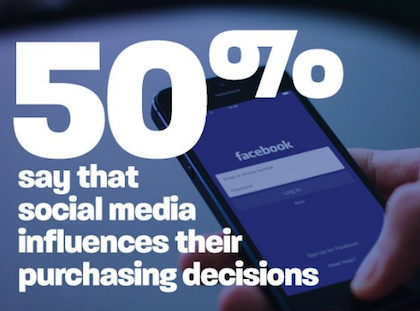 Making the right call. Image courtesy of Michael Kors
Making the right call. Image courtesy of Michael Kors
By Rakin Azfar of Mobile Commerce Daily
The relationship between social media and ecommerce is ever-evolving, and, if the results of a recent survey on social commerce from Sumo Heavy are to be heeded, the two are becoming increasingly intertwined.
The survey from Sumo Heavy, a digital commerce consulting firm, tracks the role of social media both in traditional arenas (such as maintaining brand awareness) to its growing role as the progenitor of many a significant transaction in recent years. The findings indicate that social media should be an important component in an ecommerce retailer’s playbook, but only if deployed in specific ways.
“The ubiquity of sponsored posts can work against marketers’ efforts to get consumers’ attention,” said Bart Mroz, CEO of Sumo Heavy. “For any given user, there might be numerous branded posts appearing in his or her social channels, each with its own message or CTA. All of us get fatigued by the deluge of advertising we see during nearly every hour of our lives.”
“Although sponsored posts tend to feel less intrusive, be more targeted (and hence more relevant to an individual) and blend better with their environment, they’re still advertisements, and consumers know it,” he said. “And so the tendency isn’t to tune in — it’s to tune out.
“Consumers may be connected to the brand on social media, but how meaningful is that, really? ‘Liking’ the brand doesn’t necessarily translate to truly caring what it says; what consumers do care about is what their friends and family think, say and do. So if and when an individual’s real-life ‘influencers’ talk about a brand—perhaps a product that they bought and really liked—that’s when the door really opens up for brands to make a lasting impact:a brand’s marketing department isn’t its best advertiser—its consumers are.”
2016 Social Commerce Survey
While the survey reports that ecommerce—or general commerce, for that matter—is not one of the top reasons behind social media usage (85 percent use it for friends and family; 51 percent use it to pass the time; 49 percent rely on it to stay informed with news) it seems that consumers’ relationship with social commerce is more nuanced than a mere explicit admission of motivation.
37 percent of respondents said that they consider themselves impulsive shoppers, and, the report suggests: “what better platform to capitalize on it than social media?”
 More importantly, 50 percent say that social media influences their purchasing decisions, with 42 percent reporting being influenced by what they see on Facebook, and Pinterest and Snapchat commanding 19 percent and 11 percent of users’ attentions, respectively.
Surprisingly, the only nine percent of respondents reported being influenced by what they saw on Twitter, and a shocking two percent figure was reported for Snapchat; troubling, considering the amount of money being poured into the image sharing platform’s advertising arm as of late.
Influencer marketing
Given the ubiquity of social media among consumers, thousands of brands are charging toward it, ready to launch ad campaigns and canvas user feeds with special promotions.
But the marketers and retailers should heed an all-too important figure from Sumo’s survey, that family members’ and friends’ posts about a brand and its product influences the decisions of 56 percent of respondents; surprisingly, product news and reviews carry nearly as much weight, with 54 percent.
Despite social media’s obvious favor with consumers, there is still some inertia built up against social commerce for a variety of reasons. Most of those reasons center around security concerns, with 77 percent citing security and unsecured transactions as the leading reason they do not shop directly through social media. 66 percent are worried about privacy—they don’t want personal information or shopping history out there, and 65 percent are unsure if they’re making a valid purchase.
Only 1 in 3 say it is because they’re simply unfamiliar with the process.
More importantly, 50 percent say that social media influences their purchasing decisions, with 42 percent reporting being influenced by what they see on Facebook, and Pinterest and Snapchat commanding 19 percent and 11 percent of users’ attentions, respectively.
Surprisingly, the only nine percent of respondents reported being influenced by what they saw on Twitter, and a shocking two percent figure was reported for Snapchat; troubling, considering the amount of money being poured into the image sharing platform’s advertising arm as of late.
Influencer marketing
Given the ubiquity of social media among consumers, thousands of brands are charging toward it, ready to launch ad campaigns and canvas user feeds with special promotions.
But the marketers and retailers should heed an all-too important figure from Sumo’s survey, that family members’ and friends’ posts about a brand and its product influences the decisions of 56 percent of respondents; surprisingly, product news and reviews carry nearly as much weight, with 54 percent.
Despite social media’s obvious favor with consumers, there is still some inertia built up against social commerce for a variety of reasons. Most of those reasons center around security concerns, with 77 percent citing security and unsecured transactions as the leading reason they do not shop directly through social media. 66 percent are worried about privacy—they don’t want personal information or shopping history out there, and 65 percent are unsure if they’re making a valid purchase.
Only 1 in 3 say it is because they’re simply unfamiliar with the process.
 Cyberecurity is of paramount concern, and not just within ecommerce circles. Following this weeks’ report that a hack crippled Yahoo’s security systems and compromised possibly up to 1 billion accounts, a new report has shown that more than 200 different mobile applications and Web sites were leaking personally identifiable information over the course of the last year (see story).
“The first thing to do is obvious: Make sure that customers’ information is being securely housed and encrypted, so that your brand isn’t the next one in the news,” Mr. Mroz said. “As far as social media strategy is concerned, it could be helpful to educate consumers on the security that different payment options offer, especially around social commerce—a new method on transactions that not many consumers understand.”
“But at the same time, brands shouldn’t overemphasize security and cause undue paranoia. The more alternative payment options—Paypal, Bitcoin, Google Wallet, Apple Pay, etc—that you can offer to consumers, the better. Paypal, for example, is a payment option that tends to be viewed favorably by consumers, and it reduces your liability because you’re essentially outsourcing the storage of sensitive data to a third party.”
Cyberecurity is of paramount concern, and not just within ecommerce circles. Following this weeks’ report that a hack crippled Yahoo’s security systems and compromised possibly up to 1 billion accounts, a new report has shown that more than 200 different mobile applications and Web sites were leaking personally identifiable information over the course of the last year (see story).
“The first thing to do is obvious: Make sure that customers’ information is being securely housed and encrypted, so that your brand isn’t the next one in the news,” Mr. Mroz said. “As far as social media strategy is concerned, it could be helpful to educate consumers on the security that different payment options offer, especially around social commerce—a new method on transactions that not many consumers understand.”
“But at the same time, brands shouldn’t overemphasize security and cause undue paranoia. The more alternative payment options—Paypal, Bitcoin, Google Wallet, Apple Pay, etc—that you can offer to consumers, the better. Paypal, for example, is a payment option that tends to be viewed favorably by consumers, and it reduces your liability because you’re essentially outsourcing the storage of sensitive data to a third party.”
